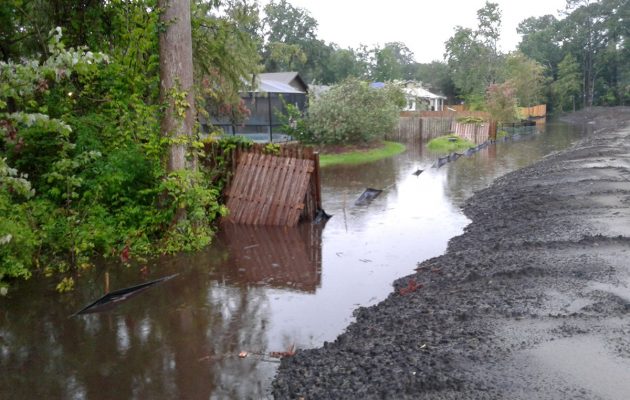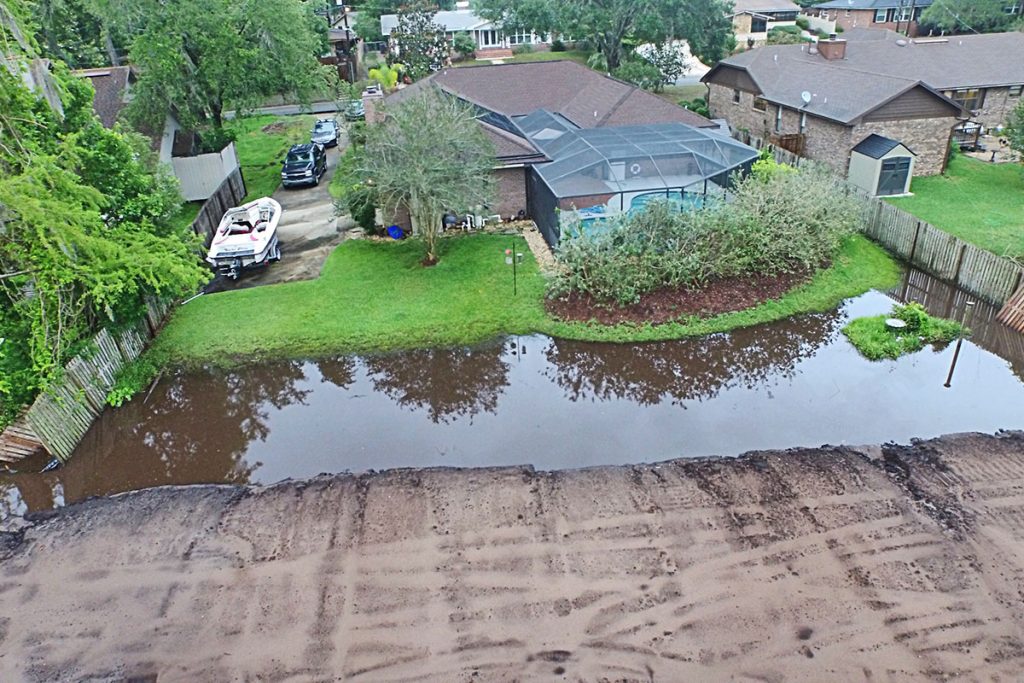Residents expand lawsuit against San Jose Estates development
Posted on July 1, 2020 By Editor Neighborhood News, San Jose, San Marco, St. Nicholas, Top Stories

If they say a picture is worth 1,000 words, Kevin Schoeppel says he has photographs to show the court that are worth 10,000.
As the lawyer representing Kevin Conner and Lynne and David Robison of the San Jose Forest Subdivision, who are suing the developer of San Jose Estates LLC for water damage to their property, Schoeppel recently filed an amended complaint with Duval County’s Fourth Judicial Circuit Court adding to the lawsuit six other parties – the St. Johns River Water Management District, Edwards Engineering and engineers Gray S. Edwards and John Anthony Quattrochi of the same firm, the City of Jacksonville, and the Jacksonville Electric Authority (JEA).
After suffering from standing water and soggy grass in their backyards for more than three years, Conner and the Robisons first filed their lawsuit Oct. 23, 2018 against the developer of San Jose Estates LLC seeking compensation to cover damage to their properties, which are adjacent to the San Jose Estates development. Conner and the Robisons claim that the developer’s apparent refusal to properly fix a faulty stormwater drainage system on six parcels of land fronting San Jose Boulevard has caused stormwater as well as the water table to rise, causing damage to their homesteads.
The San Jose Estates property was formerly categorized as “waste land,” or “jurisdictional wetlands,” on the Jacksonville Property Appraiser’s website when San Jose Estates LLC purchased the property in April 2016 for $165,000. The land is zoned as RLD-90 (residential low density with 90-foot setbacks), and it is the developer’s plan to subdivide the land into six parcels over nearly two acres, and build “luxury single-family homes” starting in the mid $400,000s, which would border San Jose Boulevard.
After repeatedly asking San Jose Estates developers Feras Mouded, who owns San Jose Estates LLC, and James O’Nan to fix the faulty drainage system, David Robison, a civil engineer, decided to take matters into his own hands two years ago. He drew up a 24-page document entitled, “San Jose Estates: A Project that Never Ends,” where he outlined a solution that he planned to immediately put into action on his own property that would to dry out his backyard. He then requested $35,000 from the developer to cover his costs. “We could not wait any longer,” said Lynne Robison in a telephone interview two years ago. “This is absolutely ridiculous. We can’t use our yard because its soaking wet. I want to be able to enjoy my property, and he’s taken that away from me for a year and a half.”
For Conner, the result of the developers clearing the wetlands – “a lake with some cypress trees in it” – and using impermeable soil to fill in their property has been devastating. Eleven months ago, he was forced to move his family out of their home due to water seeping through the foundation, soaking his hardwood flooring, and creating excessive mold within the floors and walls. Conner, who has since purchased a home elsewhere to live, is seeking compensation from the developers to cover the damage to his home, which is no longer habitable, he said.
“What it comes down to is this. There previously was a big hole in the ground that was a lake filled with trees. That was a large area for the watershed to dump water into so it could rise and lower depending upon the amount of water in there and it would never flood. It never had previously flooded anyone’s property. They took that pond and filled it with impermeable dirt so that the next time it rained the rain had to go somewhere. If there is a huge plug of dirt there then it raises the water level, but we also believe it has raised the water table,” explained Schoeppel.

“You can stand in my client’s driveway and see water running out of the driveway across the street that’s at a higher elevation than his, and that’s what we believe has happened to his home,” he continued, referring to Conner’s property. “He never had a problem with the slab, and now the slab is constantly saturated, and it has ruined his hardwood floors and molded everything. What they need to do is compensate him,” he said, noting that one option might be for the developers to purchase Conner’s home only to tear it down and make it into a retention pond. “If they measure the amount of dirt they put in their lake and make a hole with the same amount of dirt taken out of it, that will be the end of the problem, I presume. They have to find that hole somewhere. They are either going to have to take one of their lots and dig a big hole there and make it into a retention pond, or I’ve noticed there is a for-sale sign on the lot immediately south of their property. They could buy that and create a pond, or they may buy my client’s house, if it is not worth repairing, and get permission from the City to take it out of there and make a retention pond for their overflow. What amazes me is that they destroyed the lake with cypress trees.”
Schoeppel said he had given the St. Johns River Water Management District, JEA, the City of Jacksonville, and Edwards Engineering, as well as the two engineers six months’ notice as required by law to make amends without being sued. He said he found it to be particularly interesting that JEA, especially, did not respond because the drainage problem often causes its sewerage lift station on the corner of Madrid Avenue and LaVaca Road to overflow. “We have videos of it overflowing into the water that goes into my client’s and other people’s properties and across LaVaca Road and into the river,” Schoeppel said. “That’s human sewerage in that park, and children play in that park. Here you have a lift station that overflows, and that is raw sewerage running out of it. When you have four inches of water over the lift station, it’s overflowing.”
Schoeppel said he has served Gray Engineering and its two engineers, Gray S. Edwards and John Anthony Quattrochi first, but has not yet served St. Johns River Water Management District, The City, or JEA. He said he thought about also suing the Florida Department of Transportation because it gave the developers access to San Jose Boulevard’s stormwater sewer system through a 15-inch valve. “We left FDOT out,” he said. “We can’t see that made much difference, so we didn’t sue FDOT.”
San Jose Estates’s lawyer, Theresa Carli Pontieri of Carli Law PLLC, filed an answer with the court to Schoeppel’s complaint on June 8. In it the developers “generally deny any and all allegations contained within the Plaintiff’s complaint and demand strict proof thereof as required by the Constitution, Statutes, Laws and Rules of Civil Procedure,” according a legal document filed in the Circuit Court of the Fourth Judicial Circuit in Duval County.
“I think it will be resolved, and I don’t know how it could be resolved in the developer’s favor,” said Schoeppel. “I have photographs. Aerial photographs of the flooding because we flew a drone over. I don’t care what their engineer has to say as an expert, I have these pictures. These pictures are worth 10,000 words.”
By Marcia Hodgson
Resident Community News




 (2 votes, average: 4.50 out of 5)
(2 votes, average: 4.50 out of 5)




